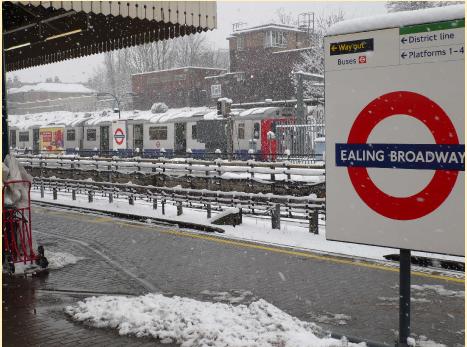The coming of the railways had a profound effect on the development of Ealing with the Great Western Railway arriving in 1838 and the District in 1879. What we now know as the Central Line was originally built as a freight line for the Great Western Railway connecting Ealing with the West London Railway near Shepherds Bush, but with electrification and a connection to the Central London Railway at White City, passenger services started in 1920. It seems that the Great Western Railway considered itself to be primarily an "Inter-City" route rather than a commuter line, and their terminus at Paddington was still some way from the commercial centre of London. The opening of the Metropolitan line from Paddington to Farringdon in 1863 would have helped, but the housing boom in Ealing did not really take off until the arrival of the District. Classic "Victorian" style houses, built of brick with pitched and gabled roofs, bays and large sash windows, went up in great numbers between about 1880 and 1910. There were long terraces of relatively small houses usually with three bedrooms, larger semis perhaps with accommodation for a live-in maid, and larger detached houses seen in the grander roads of the borough. As the expansion was mostly into what was until then open country, all the houses would have had gardens, some of them quite large. There were some Maisonettes, usually providing two flats, one on the ground floor and one on the first, and these buildings had a very similar external appearance to the normal houses. Even flats such as these had their own gardens formed by dividing the plot. This is in stark contrast to the 21st century building policy which consists mostly of large blocks of flats with no outside space.

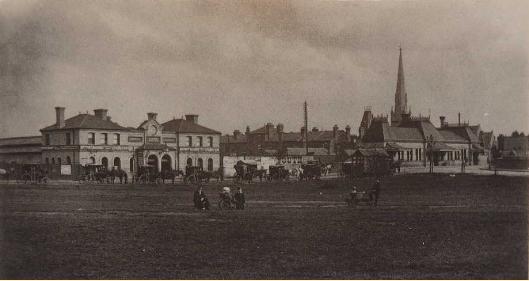
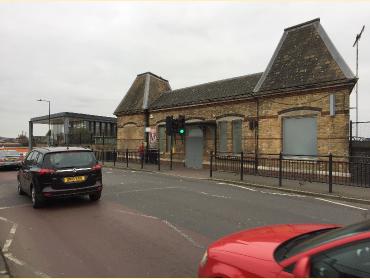
This photograph (above left) was taken in about 1880 and shows the District Line station on the left, and on the right (with the spire of the Ealing Broadway Methodist Church behind) the Great Western Railway station. This was actually a replacement for an earlier station, but survived until re-development work in the 1960's mainly to allow the then British Railways to generate income from retail and other units on the site. The District Line station was also rebuilt and the replacement still stands, although converted into shops. The "modernised" Ealing Broadway station of the 60's had a single entrance and ticket hall to serve the main line, Central and District lines, and at the beginning of the 21st century was already far too cramped for the passenger numbers - particularly in the rush hours. A new station is being created for the much delayed Crossrail or Elizabeth Line service, and at the time of writing (2021) is nearing completion. Southall station (photo above right, taken in December 2021) was built to a similar design as Ealing Broadway but is now (2021) boarded up and facing an uncertain future. It has been replaced by a new station building (seen to the left of the original station) complete with new platform access for the Crossrail or Elizabeth Line service.
But Ealing Broadway Station did eventually get its upgrade in time for the opening of the Elizabeth Line in 2022:
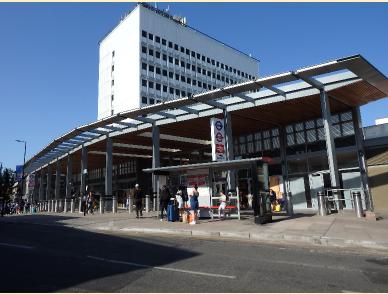
The main and most beneficial change has been to remove most of the shops to provide space for a large entrance lobby with a large number of the automatic ticket gates seen from outside (lower right) and inside (upper right). A few shops remain as well as the tower block (apparently empty in August 2023) at the northern end of the building. A large and rather utilitarian roof has been constructed over the external circulating area.
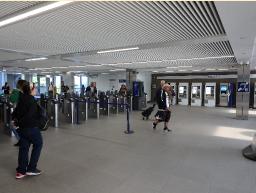
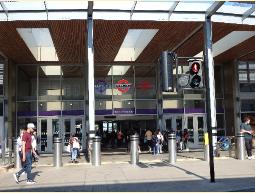
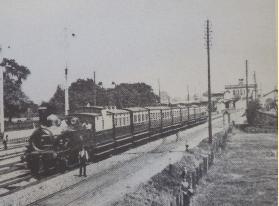
Above: Westbound train leaving what is now West Ealing Station in the 1880’s
As Ealing grew and demand for train services increased, an extra pair of running lines was added on the north side of the existing tracks, and these became the "slow" lines with the originals being the "fast" lines, generally used for through traffic. Although all stations had platforms on the slow lines, only some had them on the fast lines. Ealing Broadway was one such and its fast line platforms still exist although few if any trains now stop at them.
I know that the morning Worcester train (8:05 from Paddington) did call at Ealing Broadway in the 1970's as I used it on regular trips I made to the BBC's Engineering Training Centre near Evesham. The return service I used did not stop at Ealing Broadway, so I would change to a local service at Reading. On one occasion in late 1973 I was surprised to find no local train waiting at Reading; what's more, the train I had arrived on did not leave immediately as it usually would have.
With many others I headed for the Southern Region platforms and stood all the way to Waterloo in a stopping train. When I finally got home I found that the cause was the West Ealing Rail crash, which happened just west of Ealing Broadway Station. (Top)
The Great Western Railway served Wales and the South West, including the route to Worcester and Hereford, now called the Cotswold Line. GWR Trains even reached Birkenhead on the Mersey. The picture shows the sort of trains which would have been seen speeding through Ealing Broadway in the 1930's. This one is an express to Cheltenham Spa, actually pictured in Sonning Cutting a few miles west of Ealing.
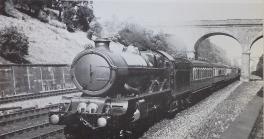
There were also local services with branches to Greenford, Brentford, Uxbridge and Staines. The last two have long since disappeared and the Brentford branch now only serves a waste transfer depot, but the Greenford service survives. When I first came to the borough (1973) it operated as a shuttle between Ealing Broadway and Greenford, and a crossover and refuge siding were provided for the single car diesel unit, but later it ran from Paddington. The paths this service occupied on the main line have recently been released for Crossrail, and Greenford is now served by a shuttle from West Ealing, where a new bay platform has been built for it. The bay has recently (2024) been equipped with fast charging equiment for an experimental battery electric train. (Top)
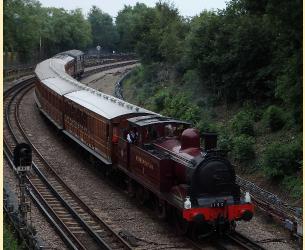
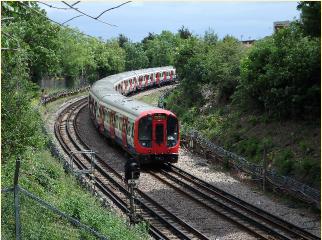
In 2019, London Transport ran a special steam hauled train to celebrate 150 years of the District Line, making three return trips between Ealing Broadway and Kensington High Street on each of Saturday 22nd and Sunday 23rd June. It was billed as the last ever opportunity to run steam on the line as new signalling systems being planned would not be compatible with steam running. The train is seen (above left) approaching Ealing Broadway on the Sunday morning. The picture (above right) shows a modern walk-through style train at the same place.
And finally a reminder of something we have not seen in Ealing for some time - Snow!
This was taken in February 2009 when I was waiting for a Central line train on my way to work.
The train in the background is on the District Line and is formed of the stock which that in the picture above replaced.
(Top)
